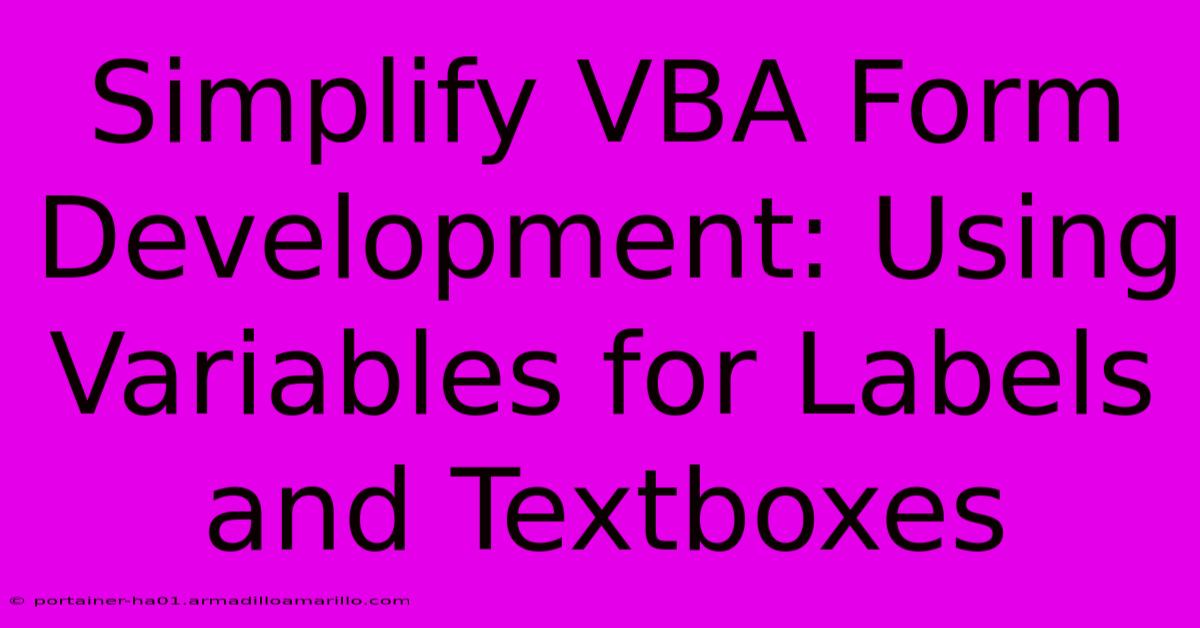Simplify VBA Form Development: Using Variables For Labels And Textboxes

Table of Contents
Simplify VBA Form Development: Using Variables for Labels and Textboxes
Developing user forms in VBA can sometimes feel like navigating a maze. Keeping track of numerous controls, especially when dealing with many labels and textboxes, can quickly become overwhelming and error-prone. This article shows you how to dramatically simplify your VBA form development by leveraging the power of variables to manage your labels and textboxes efficiently. This approach significantly reduces code clutter, enhances readability, and makes your forms easier to maintain and update.
The Traditional Approach (and its Pitfalls)
Traditionally, you might directly reference each control on your form using its name. For example:
Me.Label1.Caption = "Name:"
Me.TextBox1.Text = "John Doe"
While functional for simple forms, this method becomes unwieldy as the number of controls increases. Imagine managing dozens of labels and textboxes this way – it's a recipe for frustration and potential errors. Finding and modifying specific controls becomes a tedious process, increasing the risk of introducing bugs.
The Power of Variables: A More Elegant Solution
By using variables, you can create a much more manageable and scalable system. This involves declaring variables to represent your controls, making your code cleaner and easier to understand.
Declaring Variables
First, declare variables to hold references to your controls. The type of variable should match the type of control (e.g., Label for labels, TextBox for textboxes).
Dim lblName As MSForms.Label
Dim txtName As MSForms.TextBox
Dim lblAge As MSForms.Label
Dim txtAge As MSForms.TextBox
Setting References
Next, set the variables to refer to the specific controls on your form. This is done using the Set statement:
Set lblName = Me.Label1
Set txtName = Me.TextBox1
Set lblAge = Me.Label2
Set txtAge = Me.TextBox2
Using Variables in Your Code
Now you can use the variables to interact with the controls. This makes your code significantly clearer:
lblName.Caption = "Name:"
txtName.Text = "Jane Doe"
lblAge.Caption = "Age:"
txtAge.Text = "30"
Notice how much more readable and maintainable this is compared to the direct referencing method.
Benefits of Using Variables
- Improved Readability: Code is much easier to understand and follow.
- Reduced Errors: Less chance of typos and misreferences.
- Easier Maintenance: Changes to your form are simpler to implement.
- Increased Scalability: Easily handle larger forms with many controls.
- Better Organization: Your code is more structured and logical.
- Enhanced Reusability: Code sections can be more easily reused in other forms or projects.
Advanced Techniques: Arrays and Loops
For forms with numerous similar controls, consider using arrays. This allows you to loop through the controls, further simplifying your code:
Dim lblNames(1 To 5) As MSForms.Label
Dim txtNames(1 To 5) As MSForms.TextBox
' ... Set the array elements to refer to the controls ...
For i = 1 To 5
lblNames(i).Caption = "Name " & i & ":"
' ... process txtNames(i) ...
Next i
Conclusion
Using variables for labels and textboxes in your VBA forms is a simple yet powerful technique that can drastically improve your development workflow. It promotes cleaner, more efficient, and maintainable code. By adopting this approach, you'll find that creating and managing even complex VBA forms becomes a significantly easier and less error-prone process. Embrace this method to elevate your VBA form development skills.

Thank you for visiting our website wich cover about Simplify VBA Form Development: Using Variables For Labels And Textboxes. We hope the information provided has been useful to you. Feel free to contact us if you have any questions or need further assistance. See you next time and dont miss to bookmark.
Featured Posts
-
Sticky Note Revolution Uncover Hidden Features For Maximum Efficiency
Feb 06, 2025
-
The Blueprint For Success How To Choose The Perfect Conference Room For Your Event
Feb 06, 2025
-
Carrot Chauncey The Charred Delight Thats A Must Have For Veggie Lovers
Feb 06, 2025
-
Forge Unforgettable Nails Create D And D Inspired Nail Art That Defies The Ordinary
Feb 06, 2025
-
Simplify Vba Form Development Using Variables For Labels And Textboxes
Feb 06, 2025
